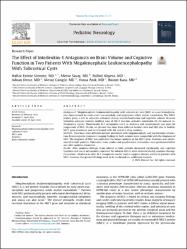The Effect of Interleukin-1 Antagonists on Brain Volume and Cognitive Function in Two Patients With Megalencephalic Leukoencephalopathy With Subcortical Cysts

Göster/
Erişim
info:eu-repo/semantics/openAccessTarih
2023Yazar
Sönmez, Hafize EmineSavaş, Merve
Aliyeva, Bülbül
Deniz, Adnan
Güngör, Mesut
Anık, Yonca
Kara, Bülent
Üst veri
Tüm öğe kaydını gösterKünye
Sönmez, H. E., Savaş, M., Aliyeva, B., Deniz, A., Güngör, M., Anık, Y., & Kara, B. (2023). The Effect of Interleukin-1 Antagonists on Brain Volume and Cognitive Function in Two Patients With Megalencephalic Leukoencephalopathy With Subcortical Cysts. Pediatric neurology, 144, 72–77. https://doi.org/10.1016/j.pediatrneurol.2023.04.008Özet
Background: Megalencephalic leukoencephalopathy with subcortical cysts (MLC) is a rare leukodystro-phy characterized by early-onset macrocephaly and progressive white matter vacuolation. The MLC1 protein plays a role in astrocyte activation during neuroinflammation and regulates volume decrease following astrocyte osmotic swelling. Loss of MLC1 function activates interleukin (IL)-1b-induced in-flammatory signals. Theoretically, IL-1 antagonists (such as anakinra and canakinumab) can slow the progression of MLC. Herein, we present two boys from different families who had MLC due to biallelic MLC1 gene mutations and were treated with the anti-IL-1 drug anakinra.Methods: Two boys from different families presented with megalencephaly and psychomotor retarda-tion. Brain magnetic resonance imaging findings in both patients were compatible with the diagnosis of MLC. The diagnosis of MLC was confirmed via Sanger analysis of the MLC1 gene. Anakinra was admin-istered to both patients. Volumetric brain studies and psychometric evaluations were performed before and after anakinra treatment. Results: After anakinra therapy, brain volume in both patients decreased significantly and cognitive functions and social interactions improved. No adverse effects were observed during anakinra therapy.Conclusions: Anakinra or other IL-1 antagonists can be used to suppress disease activity in patients with MLC; however, the present findings need to be confirmed via additional research.(c) 2023 Elsevier Inc. All rights reserved.
















